
DigiDoc
2020, updated in 2024
Project type
App
My role
Research, Ideation, Information Architecture, Wireframing, Componentization, Prototyping
Duration
3 months
Release
Never launched, personal project
Context
In October 2020, I teamed up two UX designers coleagues to solve a challenge for a UX certification course.
I chose to join the group that would solve the challenge related to personal documentation in Brazil because I face related problems and it was the topic with the fewest students interested in solving.
Solution
Our solution was an app in which users can save their personal documents and generate QR codes to share them easily and safely.
1. Framing the problem
The regionalized identification system in Brazil still leads to a decentralized approach, allowing individuals to possess multiple IDs, for example.
The use of physical documents is still in force in Brazil. According to Serasa Experian, the main coup attempts carried out in Brazil are based on the use of stolen or false IDs. With the loss of physical documents and other incidents, it is necessary to issue a duplicate.
The Brazilian government tries to estimulate document digitization through projects like DNI (National Identification Document), aiming to centralize citizens’ documents in a mobile app, including CPF and voter registration.
Despite some states adopting digital documents, citizens encounter challenges. Installing multiple apps for digital documentation is the current scenario.
2. Defining which issue to solve
Attacking the problem of decentralization in national documentation would be unrealistic, as it is a problem of gigantic complexity.
We chose to work on the problem of issuing duplicate documents. According to the General Institute of Expertise, Santa Catarina (a state in southern Brazil) annually issues 550,000 RGs and 70% are duplicates.
The reduction in the issuance of duplicates (whether motivated by loss, theft or loss of the physical ID document) is relevant because it avoids setbacks and costs for citizens and reduces the unnecessary use of government and natural resources.
Our goal
To reduce the ID documents duplicates emission by 30% in the state of Santa Catarina (Brazil) by October 2021.
3. Understanding people's behavior
We needed to find out more about people’s daily lives and behavior regarding documentation.
To guide our research plan, we gathered our assumptions about the subject in a CSD matrix.
Next, we needed to prioritize what we should investigate in our research.
Therefore, we selected the assumptions that had the greatest impact on the business if they were validated and that we had less knowledge or certainty about to be in our research.
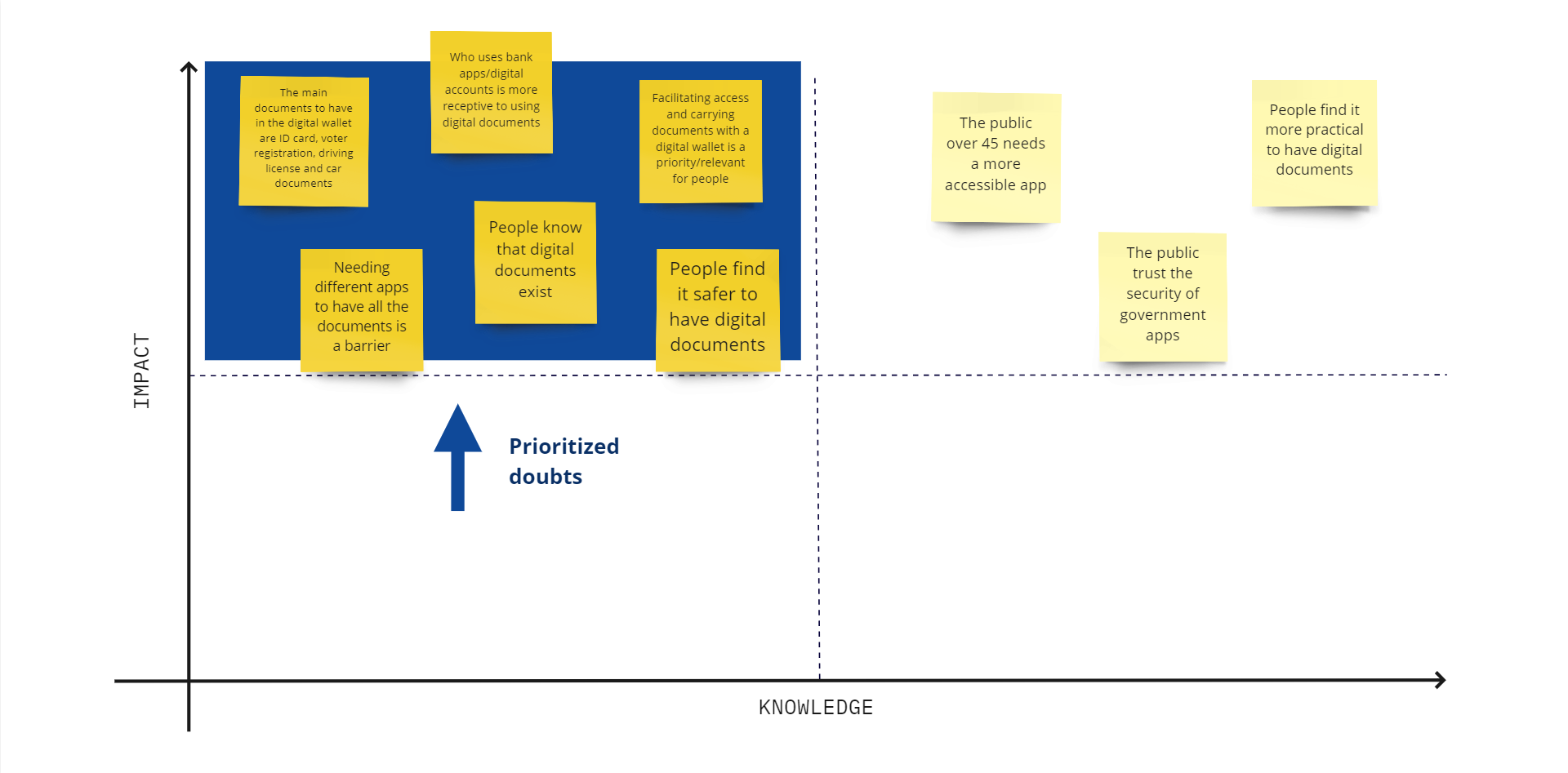
Quantitative research
For each hypothesis, we tried to create a question or set of questions that sought to investigate it. We were careful not to create biased questions, so we always based on people’s past or current behavior.
After creating the form, we disclosed it in groups related to the topic on Facebook and WhatsApp.
We collected 96 responses in two days.
We cross-referenced the questionnaire responses to extract information from the data using Data Studio and came to the following conclusions:
"We believe that people know that digital document apps exist. We will know that we are right if + 50% of people say they do."
Invalidated. 63,5% of the people who usually present their documents still use physical documents.
Note: after the research, we identified that this question should ask about the knowledge of the possibility of having digital documents, not if the person uses digital documents.
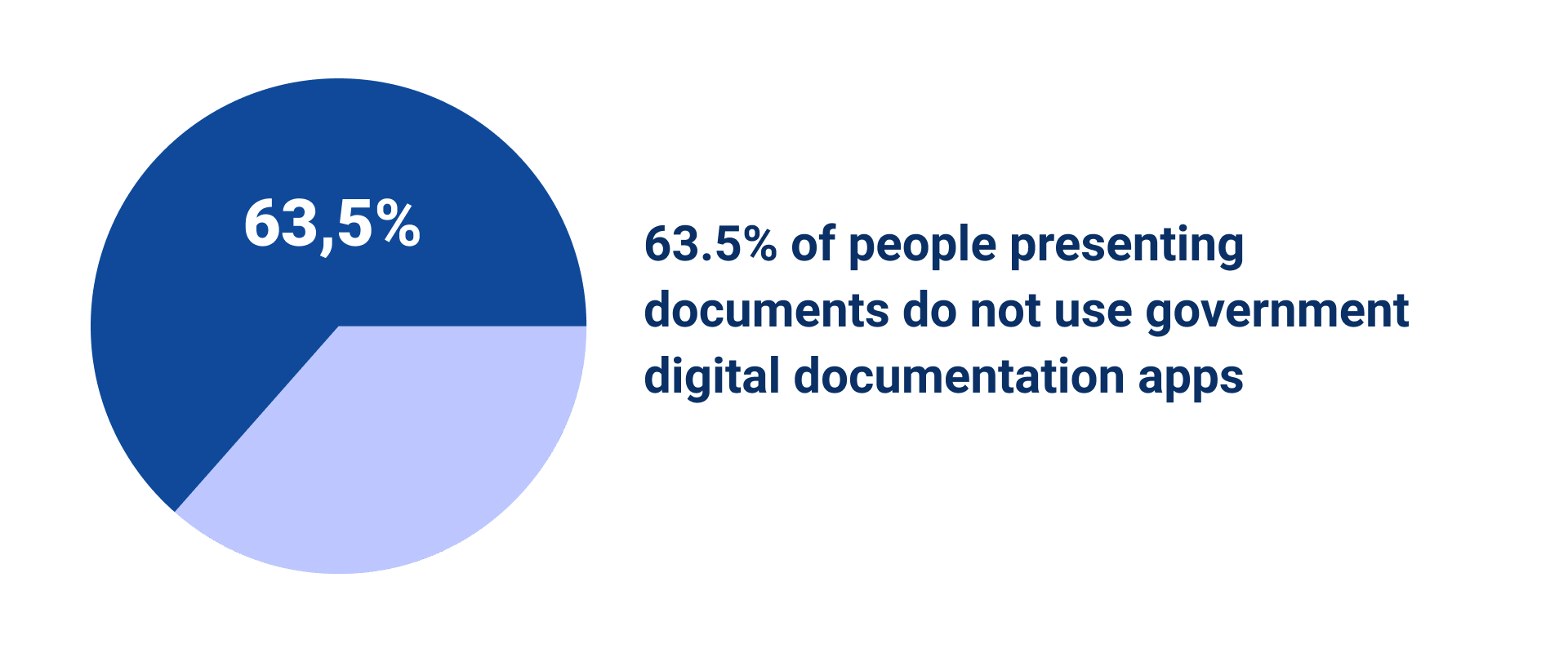
"We believe that people who use banking apps are more likely to use digital documents. We will know that we are right if + 50% respond that they use digital banks and have digital documents."
Invalidated. Only 36,6% of people who use bank apps also use government apps for digital documents.
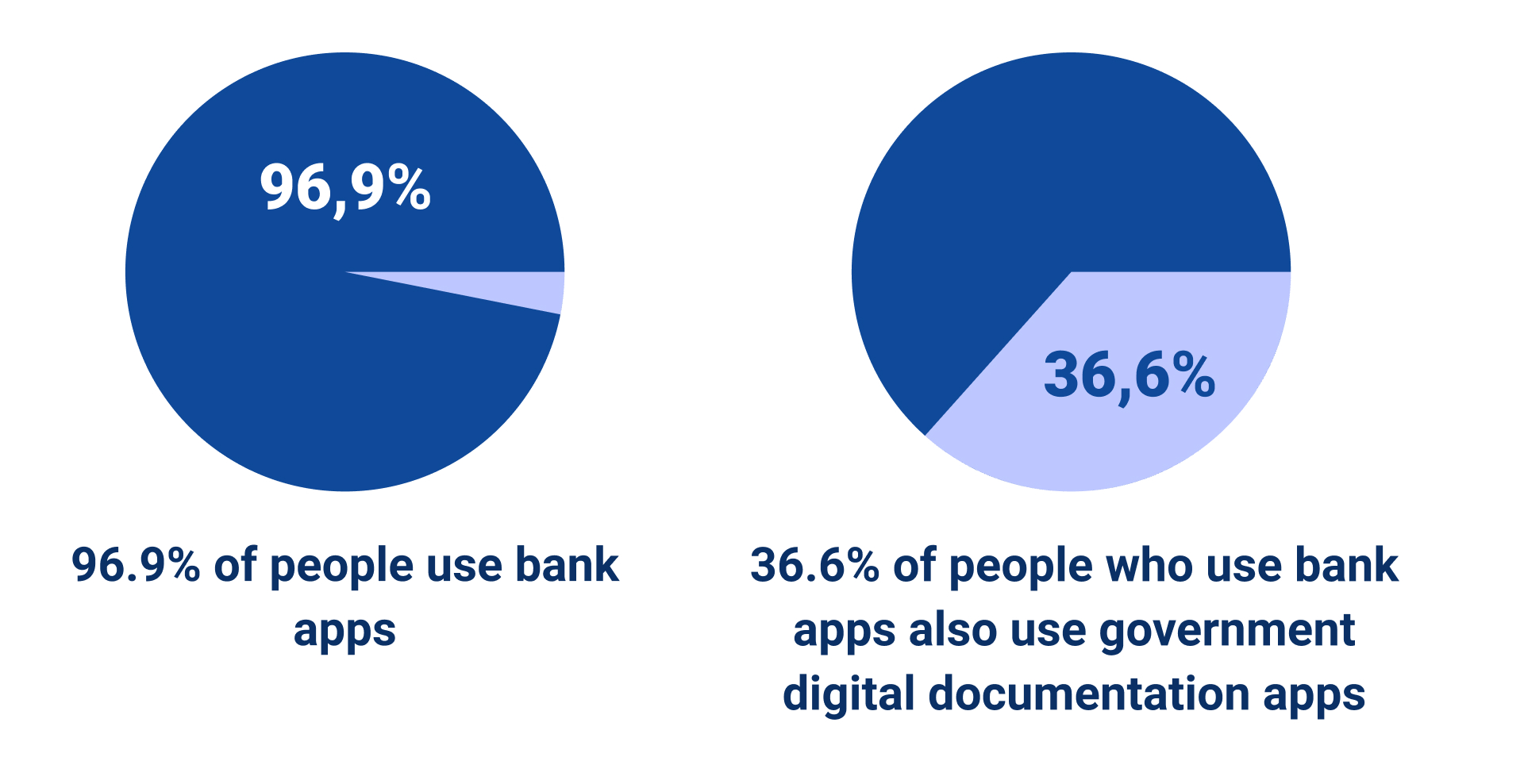
"We believe that people over 50 find it safer to have physical documents. We’ll know we’re right if 60% say they do not have digital documents."
Validated. 72.7% of people age 49 and over do not use digital documentation apps. However, 45,5% think digital documents are as safe as physical documents.
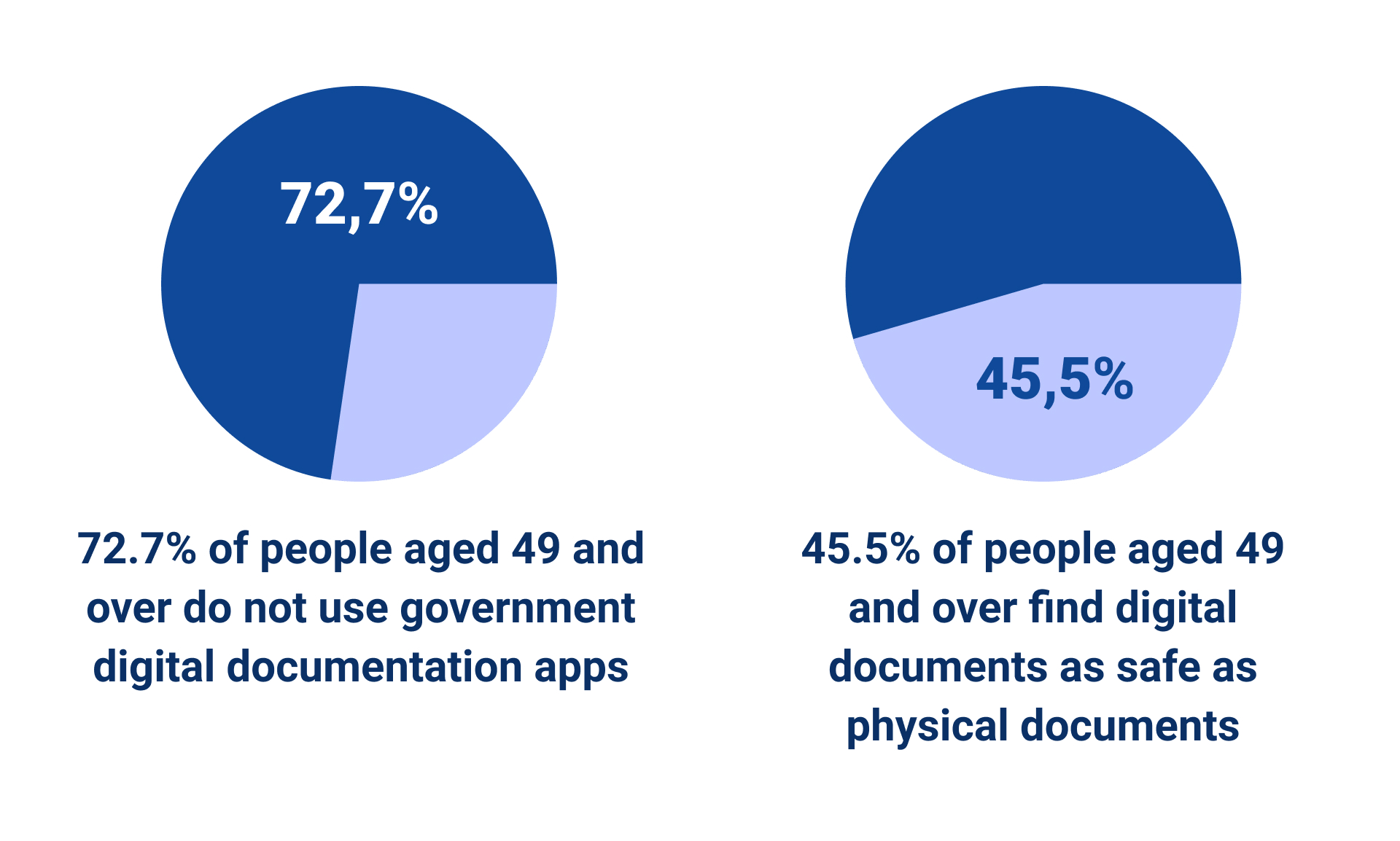
"We believe that it is important for people to have their documents always digitally accessible. We will know that we are right if 60% of people say they use documents at least 3x a week."
Invalidated. 56,3% of people use their personal documents occasionally in an average week. Only 28,1% use it more than twice.
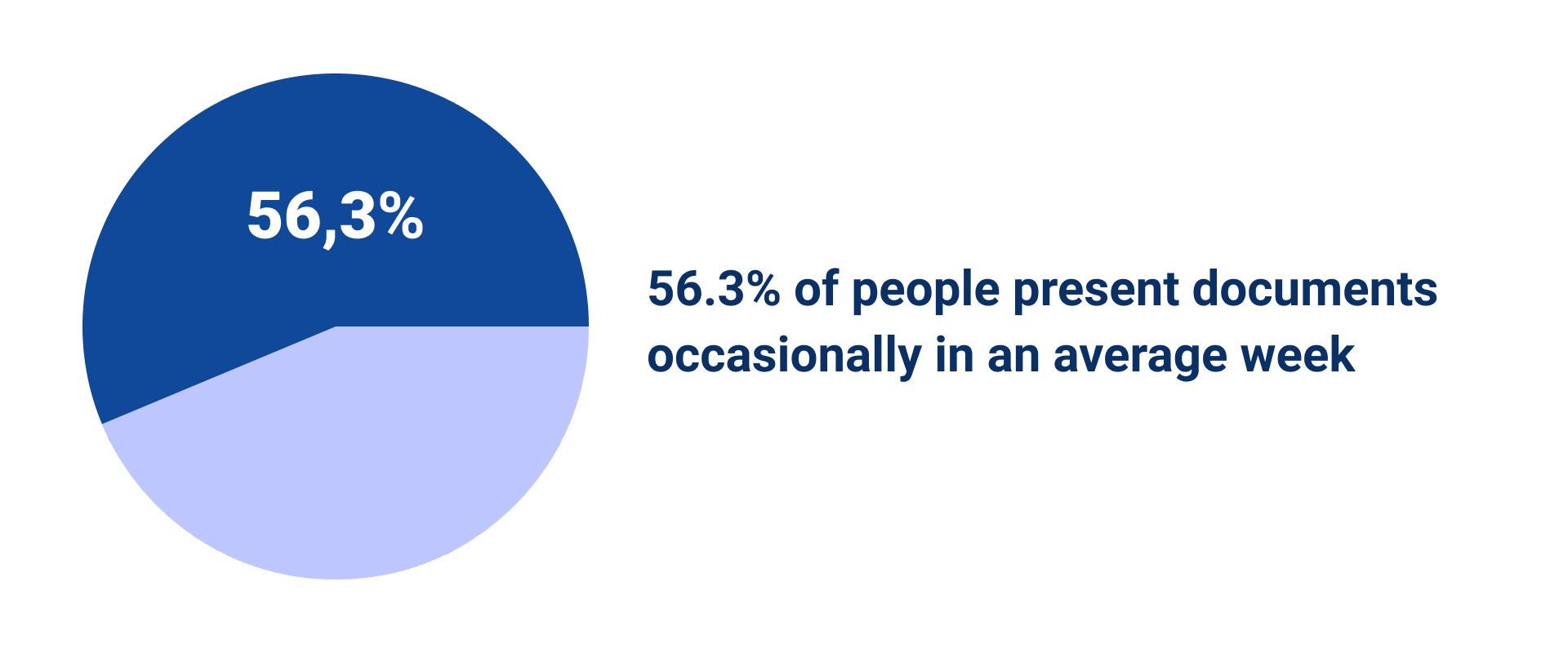
"We believe that people under the age of 40 prefer to have digital documents. We will know that we are right if 60% respond that they have one or more digital documents."
Invalidated. The use of physical documents is still the majority in all age groups surveyed.
"We believe that public servants know that digital documents exist. We will know that we are right if 70% respond that they know."
Validated. Among the people who present and check documents, 68,2% have digital documents.
Note: after the research, we identified that this question should ask about the knowledge of the possibility of having digital documents, not if the person uses digital documents.
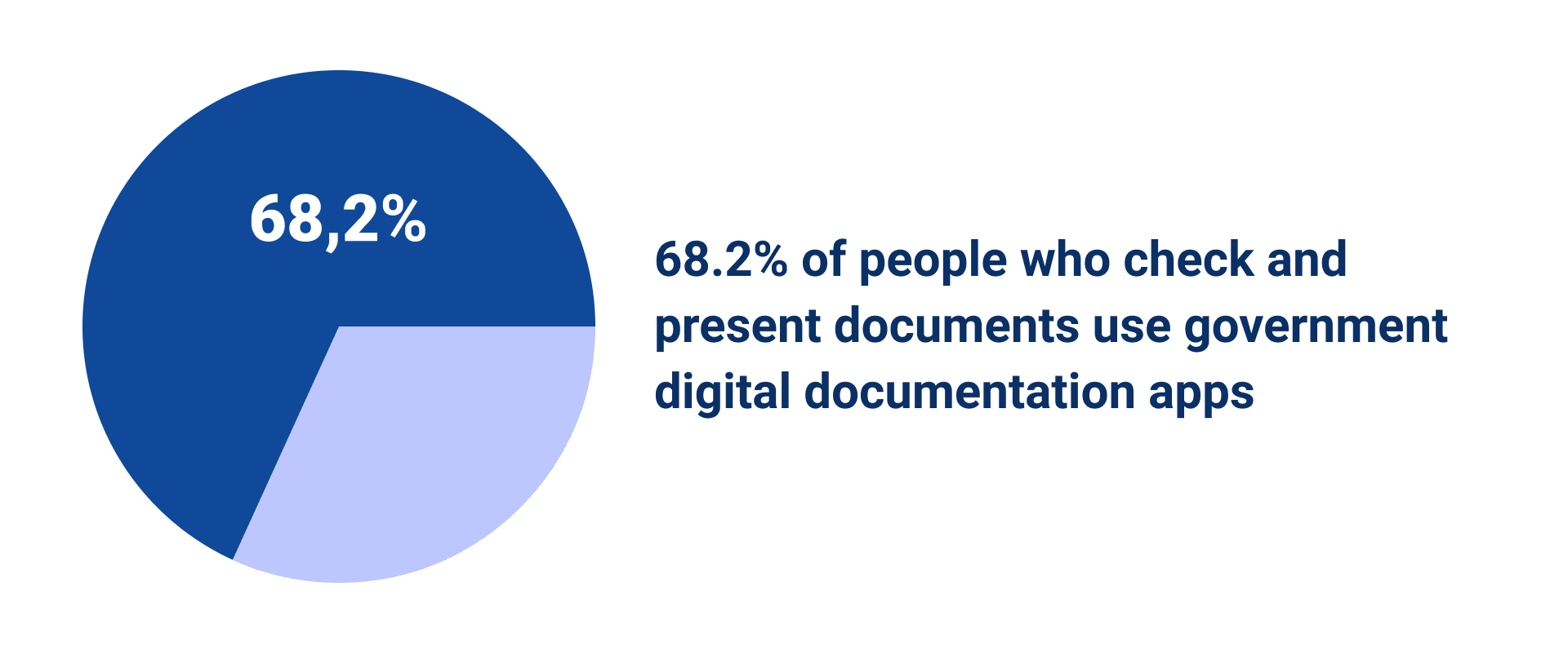
"We believe that public servers who have already checked digital documents prefer to use them. We will know that we are right if 70% say they do."
Validated. 83,3% claimed that checking digital documents is easier or as easy as checking physical documents.
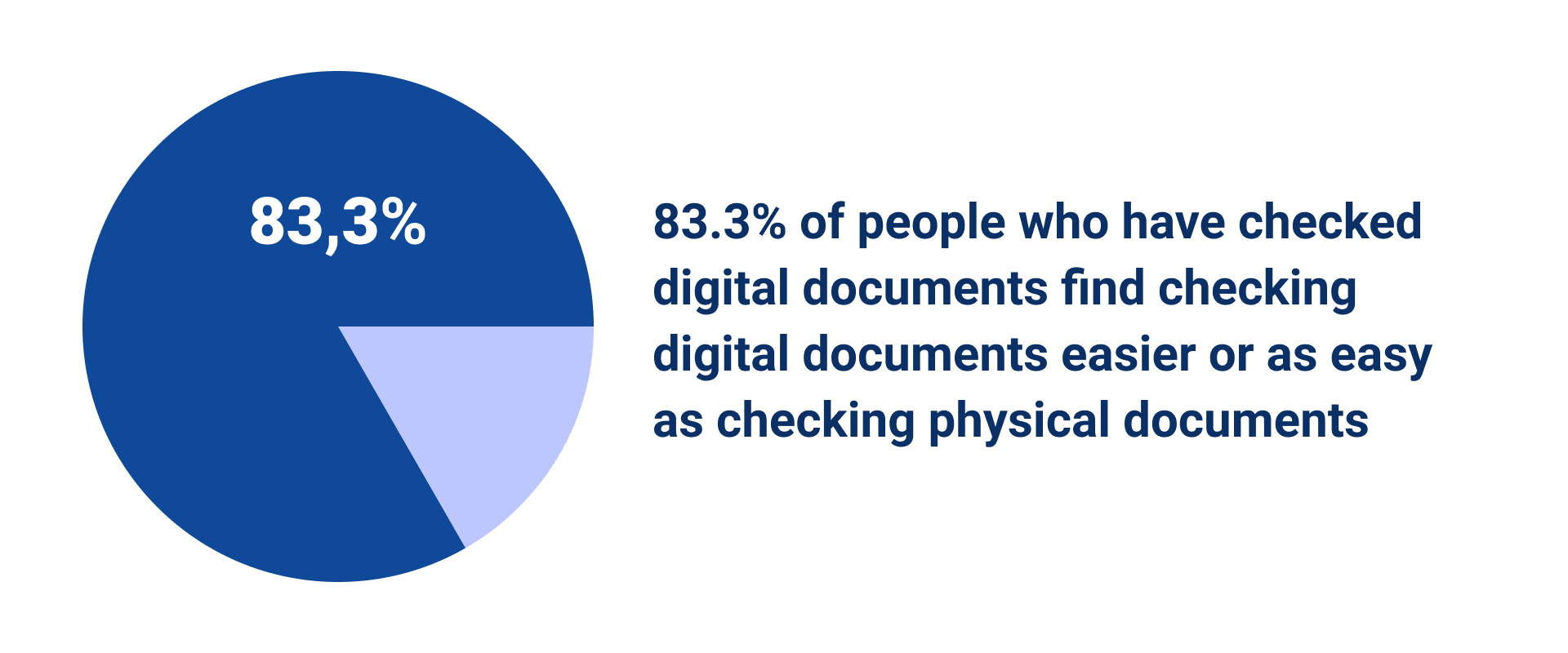
Findings
- We were able to better understand how often people use their documents and which documents are used the most;
- Most people still do not use documents digitally, although public servers are informed and open to accept digital documents;
- There is a great acceptance barrier for older people, although they do not perceive digital documents as completely unsafe;
- Using bank apps does not mean greater adoption of digital documents.
Qualitative research
We talked to 10 people from different profiles, in order to better understand their motivations behind their responses on the quantitative research and get more context.
Findings
- The lack of disclosure of the possibility of using digital documents is one of the main motivators for low use;
- The fact that it is necessary to install several apps to have all documents on the smartphone is a barrier for people to use digital documents;
- There is openness on the part of public workers to accept checking digital documents;
- Unforeseen events such as a discharged smartphone, can be a problem in the use of digital documents.
4. Our potential users
We identified as users people aged 16 to 50, who seek practicality in carrying, presenting and sharing personal documents.
A common daily routine requires the use of several personal documents, such as:
- ID card;
- Driver’s license;
- Health insurance card;
- Student card;
- Gym member card;
- And so on.
According to our research:
- The majority of people use their personal documents occasionaly in a week;
- People are receptive to the use of digital documents;
- People are dissatisfied with current government apps.
5. Defining requirements for the solution
- Provide access to digital documents that are valid and accepted in day-to-day activities;
- Allow the user to have their documents always at hand, safely;
- Allow document sharing;
- Gather all documents in one place.
How might we...
Allow the use of personal documents in a practical and safe way, reducing the likelihood of loss and damage and streamlining the document verification process?
Next, we generated solution ideas and used an Impact versus Effort matrix to analyze which idea would be more viable for the business and the user, with the intention of creating a MVP solution proposal to the problem.
Note: Since this is a course case study, we were lead to think of app solutions, although I undestand that if we were exploring the problem freely, the ideal solution could be something else.
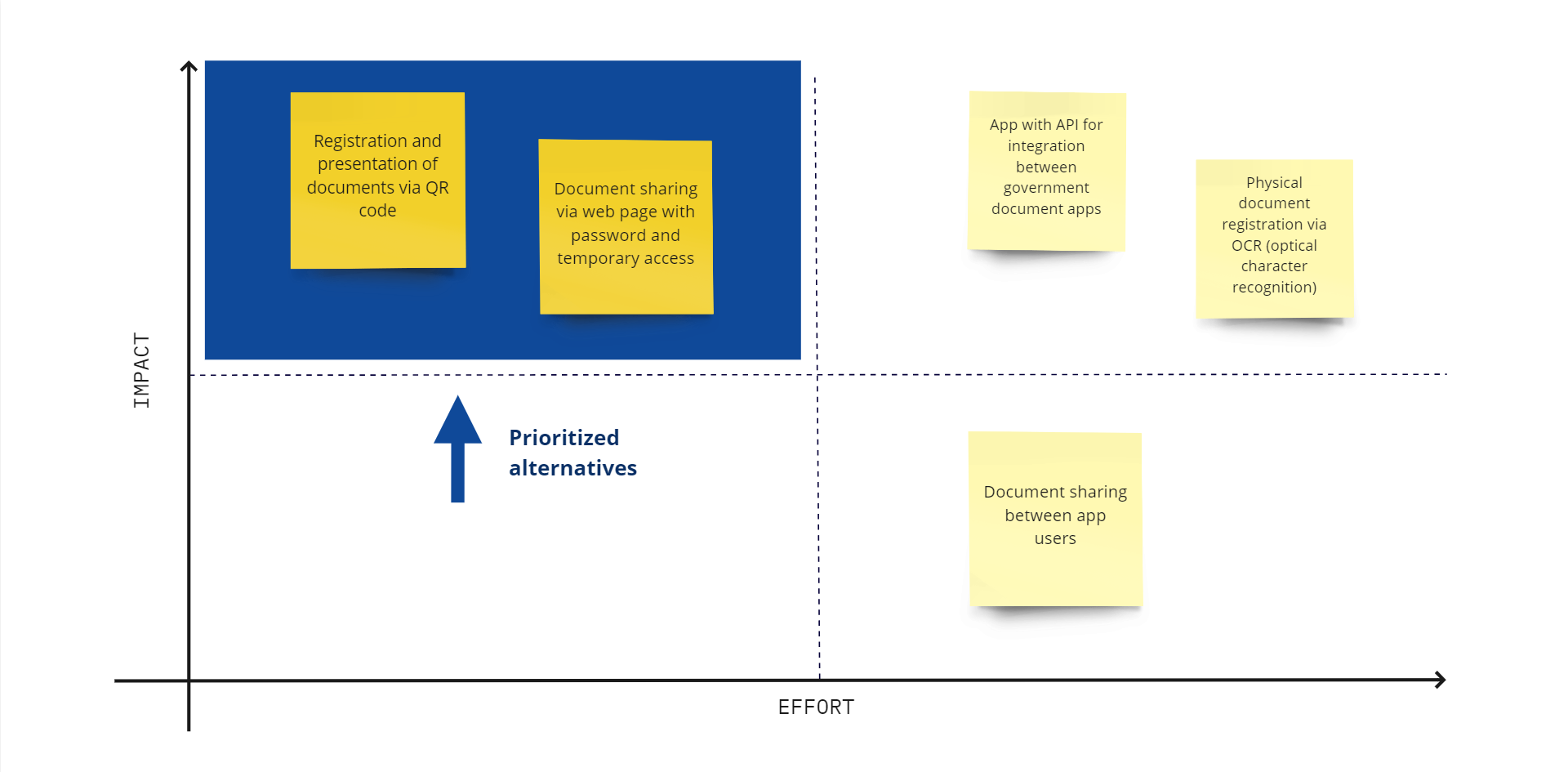
We decided to proceed with a solution based on allowing access to personal documents digitally, with the registration of documents on the platform via QR code or through a manual registration of the document data.
After registration, the document data and its QR code are available on the platform for consultation, sharing and presentation to public servers and business establishments in general.
Our solution
An app in which users can save their personal documents and generate QR codes to assist in the verification and sharing of documents - safely.
We opted for this alternative focused on the use of QR codes for a few reasons:
- It is a technology widely used (including in commercials on television) and known by a large mass of people, which makes our solution more familiar and intuitive;
- Current documents in Brazil already contain printed QR codes, so it is an initiative already officially approved by the government and known by people.
The option of integrating all documents into a single app through an integration API between existing government apps would require an advanced knowledge of technology and a complex initiative to encourage the various agencies to standardize data among themselves.
The option to register photos of documents on the platform and scan them via OCR (Optical Character Recognition) would involve a technology that we do not know in depth and which we consider less dynamic and attractive than the technology of QR codes.
6. Designing the app
We revisited everything that was discovered, making notes of the most important points that had stood out so far.
Each of us started to draw the app’s screens and shared with each other to unite the team’s ideas, transforming everything into a single consolidated sketch.
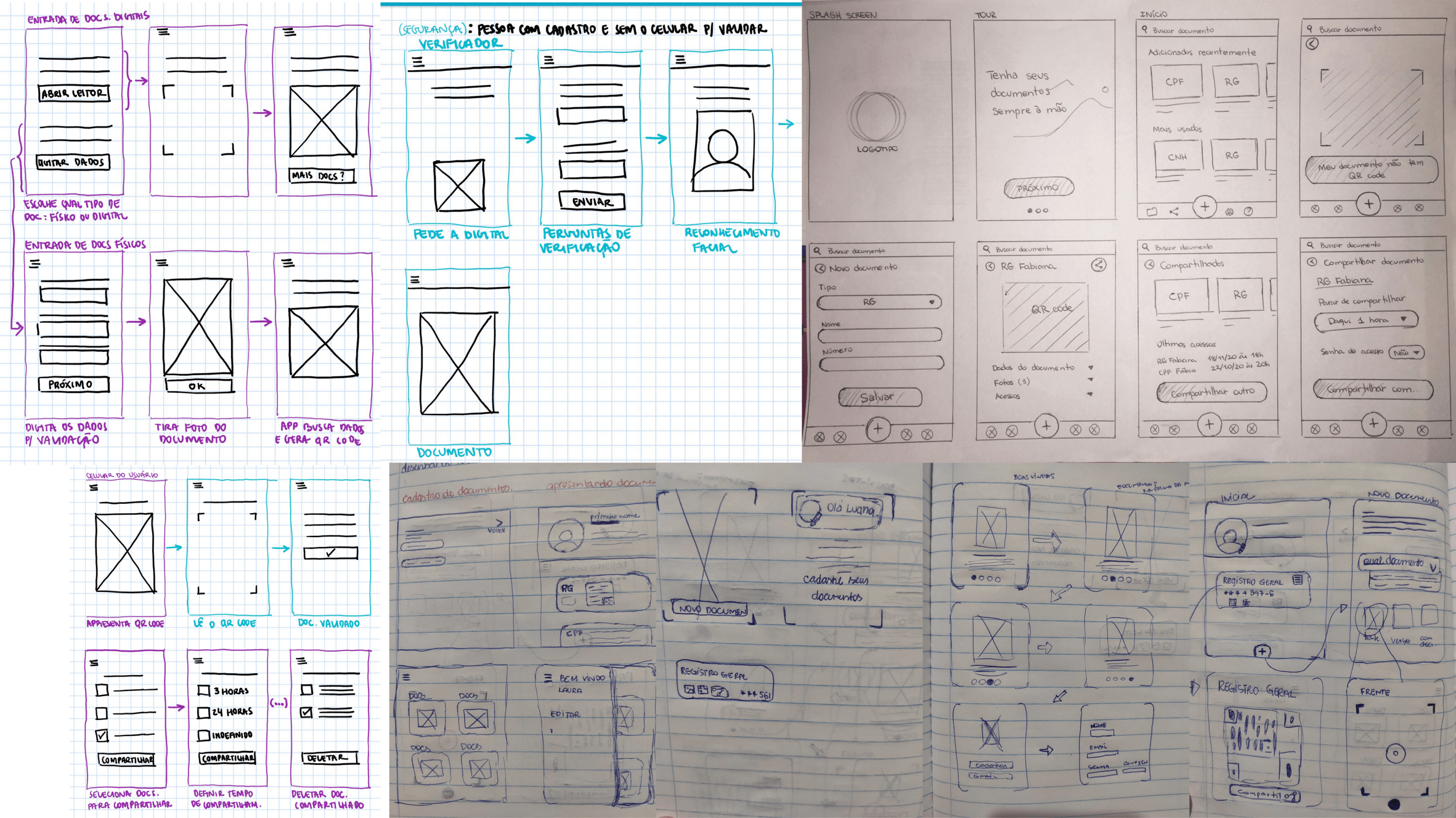
Drafts we made when designing the app.
First usability test
We created our low fidelity prototype on paper, using Marvel app.
We did usability tests with 8 people to get feedback.
We asked people to imagine themselves in a scenario where they needed to schedule a very important medical appointment and needed to share their ID temporarily with the clinic.
This task made the users go through the whole flow, having to add a document to the app and share it with others.
In general, all users were able to simulate adding a new document to the application and sharing it. The tests were important to identify small points of friction in the navigation of the app.
Understanding and defining screen relationships
we already had an idea of the user flow on the app.
But we still felt the need to visualize the whole app and it’s screens relationships, so we created a user flow.
That helped us defining what screens we needed to design.
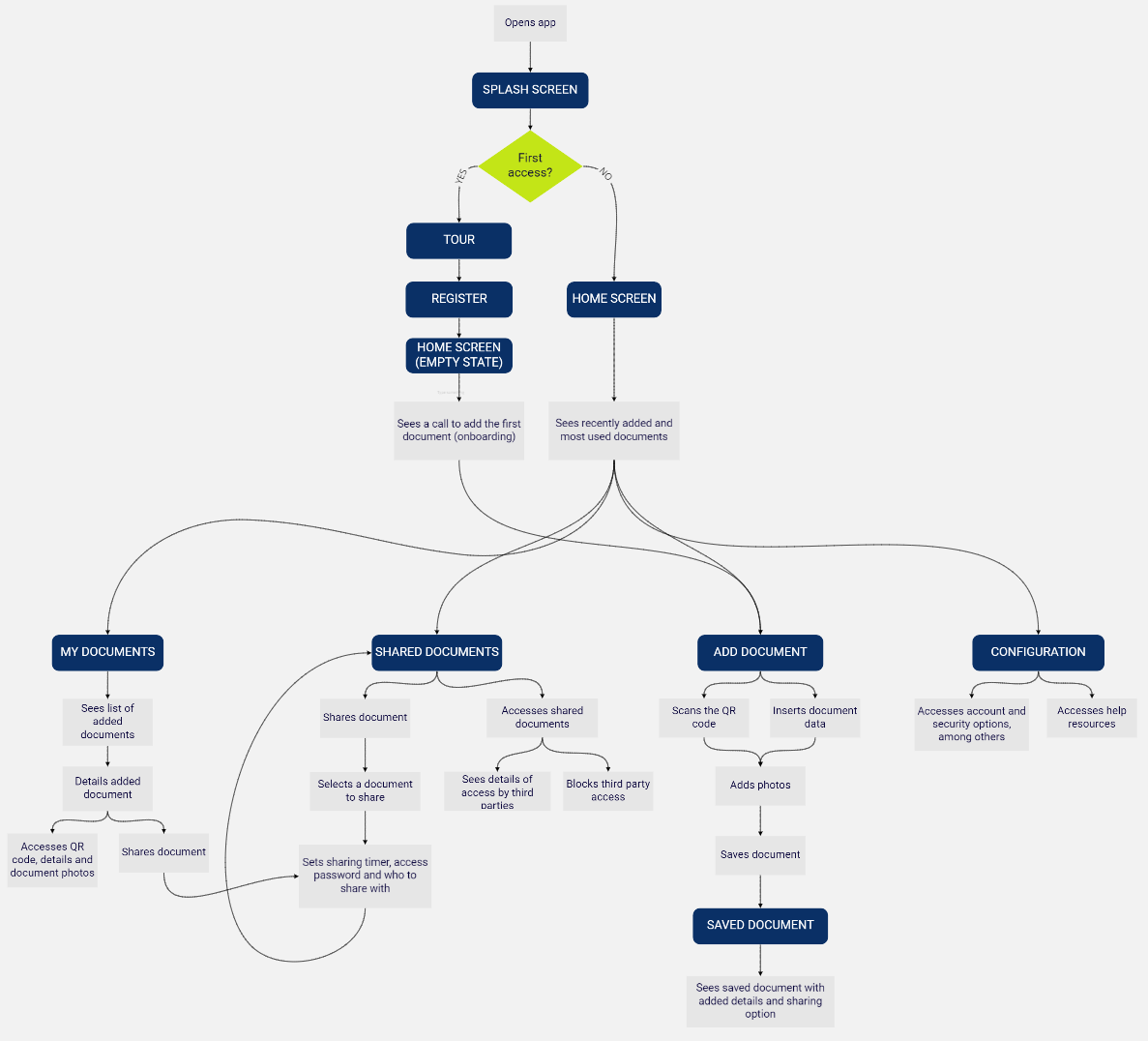
Finally, UI and visual design
Style guide (improving)
The styles and components of the brand such as color palette, typography and buttons have been documented and designed to be scalable and reused, facilitating long-term implementation and management.
A concern we had was choosing elements and colors that present good contrast and readability, to contribute to the app’s accessibility.
MVP's high fidelity prototype (improving)
Based on the user flow, wireframes and style guide, we started our hi-fiprototype.
In November 2023, I decided to redesign the screens to correct some structural, usability and design flaws.
I want to better connect our research findings to the solution itself, keeping in mind to:
- Simplify the visuals
- Create a better information architecture for the app
- Organize the data in a better way on the screens
DigiDoc’s prototype with some ongoing improvements.
Learnings and next steps
With this project, we had the opportunity to learn, experiment and work together through the different phases that a new product can go through during its conception.
I updated the prototype to implement some improvements on the app’s UI in November 2023.
If we would continue this project, the next step would be to carry out another round of usability testing, now with the high-fidelity prototype.
A year after launch, we would have to verify if the emission of duplicates of ID documents in Santa Catarina actually decreased by 30%.
If I were working on this project currently, I would try to define metrics and indicators more directly related to the adoption and use of the product, rather than just having a goal that involves the external environment, which can be affected by countless variables.
